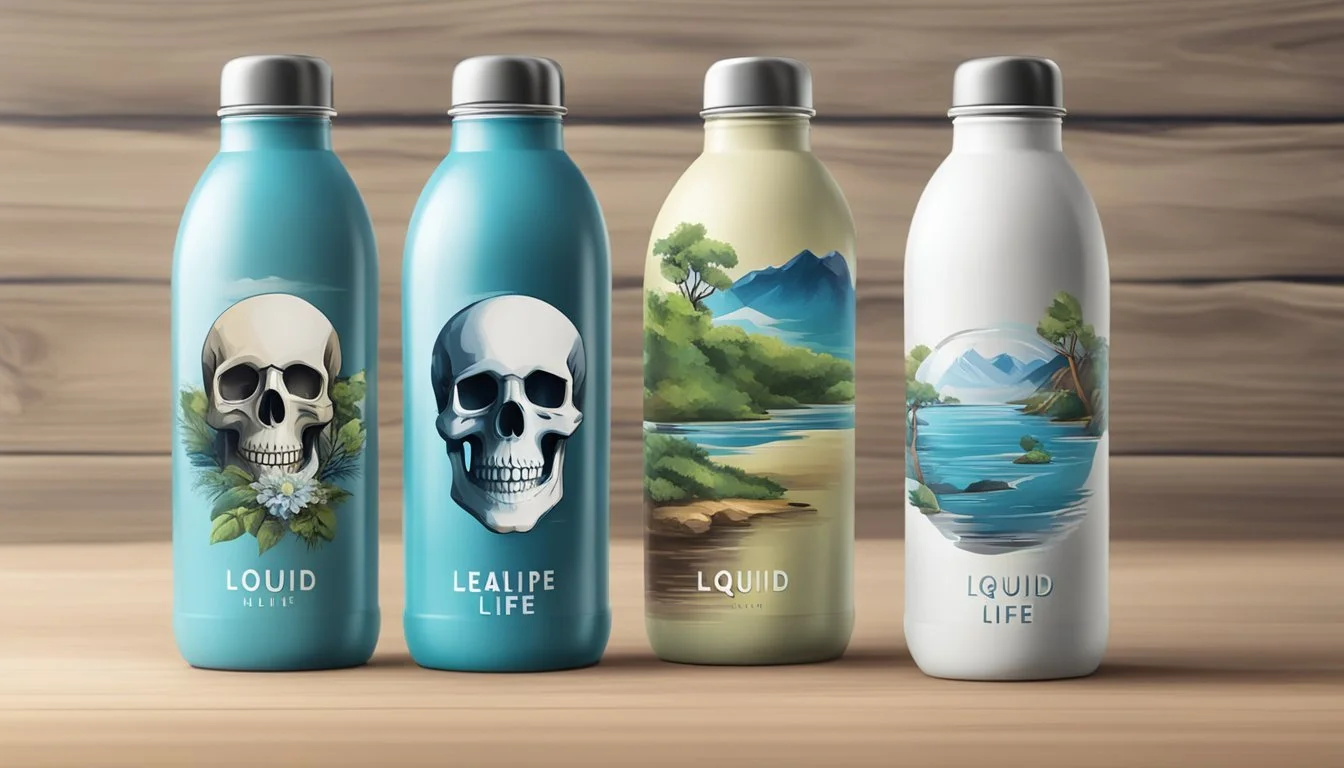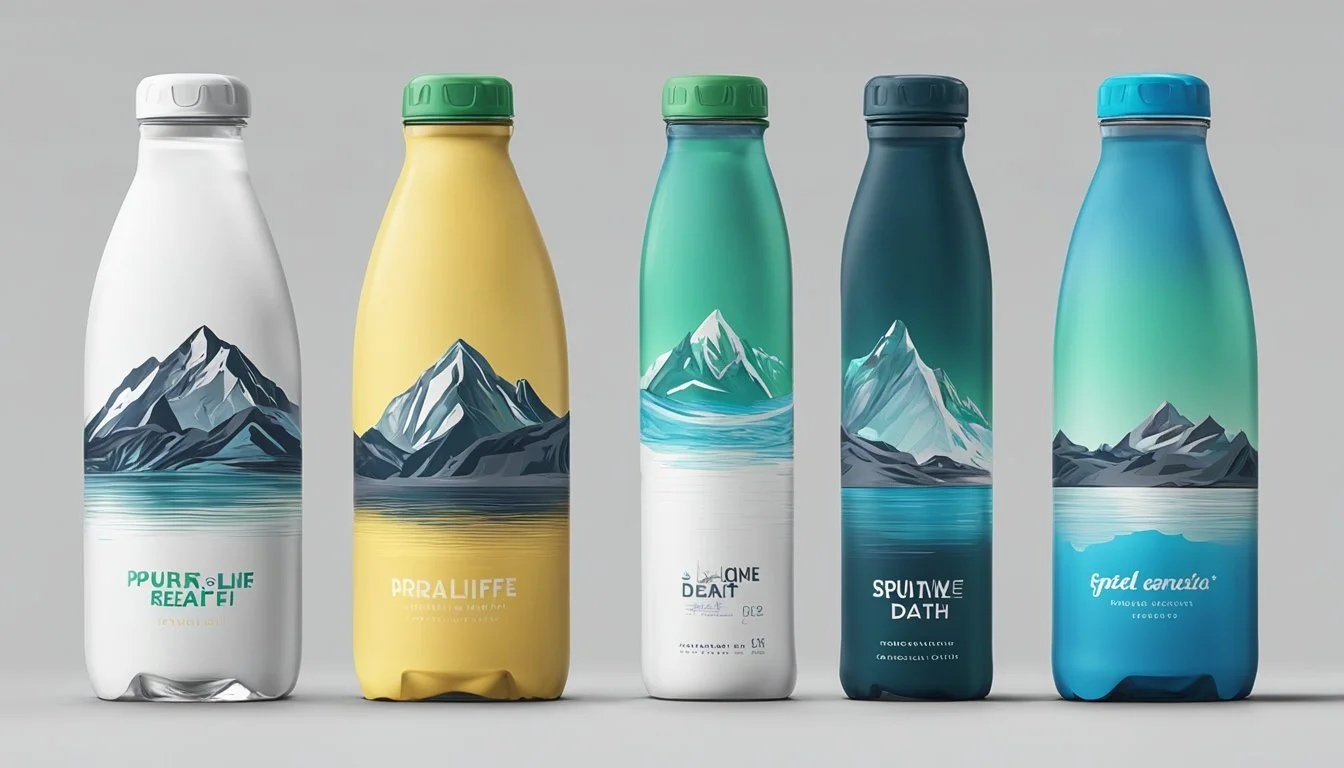Liquid Death vs. Pure Life
Comparing Bottled Water Quality
In the world of bottled water, two prominent names stand out: Liquid Death and Pure Life. Liquid Death, known for its edgy branding and availability in both sparkling and flat options, boasts a presence in major retail outlets like Whole Foods and 7-11. Pure Life, on the other hand, holds the distinction of being part of the largest bottled water corporation, Nestlé, though it is often seen as a standard choice in the market.
When comparing the two, Liquid Death's unique marketing and rapidly growing sales, particularly during the pandemic, give it a distinctive edge in terms of brand visibility and consumer engagement. Pure Life, despite its widespread recognition, is sometimes criticized for its ordinary taste and lack of distinguishing features.
Consumers today are increasingly concerned about what’s in their bottled water, with reports such as those from Consumer Reports highlighting the presence of toxic PFAS chemicals in some brands. This aspect of safety and quality makes the comparison between Liquid Death and Pure Life not just about taste, but about trust and health considerations as well.
Understanding Bottled Water
The bottled water industry is rich with history and variety, offering consumers choices that fit different tastes, lifestyles, and health preferences.
The Emergence of Bottled Water Brands
The rise of bottled water brands has transformed the water consumption landscape. Initially, this market was dominated by well-known names like Evian and Perrier.
As the industry evolved, brands such as Fiji and Topo Chico gained popularity by emphasizing unique sources and premium quality.
Recent entries like Liquid Death and campaigns like "Murder Your Thirst" show how branding and packaging play a critical role in the market. Companies now use eco-friendly materials and emphasize the purity and origin of their water, tapping into consumer concerns about health and environmental impact.
Types of Bottled Water
The market offers various types of bottled water catering to diverse preferences. Spring water, sourced from natural springs, is prized for its minerals. Fiji leverages its origin from an artesian aquifer in the South Pacific, emphasizing purity and mineral content.
Sparkling water brands like Topo Chico add carbon dioxide for a fizzy effect.
Mountain water from brands such as Evian is sourced from unique mountainous locations and features a distinctive taste. Standard choices like Aquafina provide purified water with added minerals for taste.
Each type has distinct features ensuring that consumers can choose based on preference, convenience, and perceived health benefits.
Brand Profiles
This section will explore the distinct branding and market strategies of Liquid Death and Nestle Pure Life, highlighting key aspects such as their unique philosophies and market positions.
Liquid Death: Branding and Philosophy
Liquid Death positions itself as an edgy and unconventional brand. Its primary product, mountain water sourced from the Austrian Alps, is packaged in aluminum cans, which are touted as more environmentally friendly compared to plastic bottles. This aligns with the brand's emphasis on sustainability.
Liquid Death adopts a rebellious and bold marketing approach. The brand name and visuals, which often feature skulls and dark themes, target a younger, millennial audience. They leverage distinctive slogans like "Murder Your Thirst" and use viral marketing strategies to set themselves apart from traditional water brands.
They also engage in environmental campaigns, donating a portion of their profits to initiatives aimed at reducing plastic pollution. This commitment to sustainability, coupled with a unique branding strategy, makes Liquid Death stand out in the competitive bottled water market.
Nestle Pure Life: Market Position and Reach
Nestle Pure Life, a product of the global corporation Nestlé, is one of the most recognized bottled water brands worldwide. It targets a broad consumer base, positioning itself as a reliable and accessible source of hydration. Nestle Pure Life emphasizes water quality and safety, often highlighting their extensive purification process.
Nestle Pure Life has a significant market reach, available in a wide array of retail outlets, including supermarkets, convenience stores, and online platforms such as Amazon. This extensive distribution network ensures that it is readily accessible to consumers globally.
While the brand tends to adopt more conventional marketing strategies compared to Liquid Death, it focuses on trust and reliability. Nestle Pure Life's widespread availability and consistent quality help maintain its strong presence in the bottled water market.
Water Sources and Content
Liquid Death and Pure Life differ significantly in their water sources and mineral composition. Liquid Death prides itself on its natural mountain spring origin, while Pure Life primarily relies on filtered municipal sources.
Source Water: Springs vs. Municipal Supplies
Liquid Death sources its water from deep underground mountain springs. This natural springwater is marketed as 100% pure and protected by natural stone barriers.
In contrast, Pure Life primarily uses filtered municipal water. This involves sourcing water from local municipalities, which is then treated and purified to ensure it meets safety standards.
While both sources are safe for consumption, the distinction lies in their origins: natural springs for Liquid Death and treated tap water for Pure Life.
Mineral Content and Health Considerations
Liquid Death retains its natural minerals through minimal processing. This includes essential minerals such as calcium and magnesium, which may provide health benefits.
Pure Life, utilizing municipal water, often involves processes that may strip or add minerals. The resultant product has a different mineral profile, typically aiming to match standard drinking water.
It is important to note that excessive minerals, including heavy metals, can pose health risks. Both brands undergo stringent testing to ensure safety. Consumers should consider their individual health needs and preferences when choosing between natural spring water with inherent minerals and filtered water designed for purity.
Environmental Impact
Examining the environmental impact involves looking at the sustainability of packaging materials and the costs related to production and recycling. It's essential to understand how aluminum cans and plastic bottles differ in their environmental footprint.
Bottles vs. Cans: Packaging Sustainability
Plastic bottles are widely used in the bottled water industry but have a low recycling rate. Many plastic bottles end up in landfills or oceans, causing significant environmental harm.
Aluminum cans, like those used by Liquid Death, boast a higher recycling rate. Aluminum can be recycled indefinitely without losing quality, making it a more sustainable option.
Glass bottles are another packaging alternative but are less common due to their weight and higher transportation costs. Despite being recyclable, they are less environmentally efficient than aluminum.
Environmental Cost of Production and Recycling
Producing plastic bottles requires fossil fuels and results in a high carbon footprint. Recycling plastic is also less efficient compared to aluminum, with a notable portion of plastic waste not being recycled at all.
Aluminum production is energy-intensive; however, recycling aluminum uses 95% less energy than producing new aluminum. Hence, cans are a more sustainable choice in the long term.
The production of glass bottles requires substantial energy, primarily from high-temperature processes. Although recyclable, the overall carbon emissions from glass production and transport can be higher compared to aluminum cans.
Health and Safety
When considering Liquid Death and Pure Life bottled waters, it is important to examine their health implications and safety standards. Both brands have their strengths and challenges related to chemical contaminants and regulatory oversight.
Chemical Contaminants and Water Safety
Chemical contaminants in bottled water can affect health significantly. Liquid Death prides itself on being free from toxins like lead and heavy metals, which can be harmful even in small amounts. By sourcing its water from alpine springs, Liquid Death aims to ensure a clean, natural taste.
However, microplastics are a growing concern in bottled water. Studies suggest that even the highest-quality brands may contain microscopic plastic particles. Consumer awareness around this issue has increased, pushing companies to improve their filtration processes.
Pure Life, a brand from Nestlé, also emphasizes stringent quality checks to minimize contaminants. Though both brands follow rigorous testing, the presence of microplastics remains a challenge industry-wide. Testing for heavy metals, lead, and other toxins is a critical component of their quality assurance protocols.
Regulations and Expert Opinions
Both Liquid Death and Pure Life adhere to strict regulations to ensure the safety of their products. They are required to meet standards set by regulatory bodies like the FDA and EPA, which dictate allowable levels of contaminants. Compliance with these regulations helps maintain consumer trust and ensures product safety.
Experts in the field, including dietitians and environmental scientists, highlight the importance of these regulations. They argue that even trace amounts of toxic substances can have long-term health effects. Regular testing and transparent reporting are vital for maintaining safety standards.
In terms of expert opinions, Liquid Death receives praise for its minimalist ingredient list and eco-friendly packaging. Pure Life also garners approval for its consistent quality and adherence to safety protocols. Both brands are generally considered safe by health professionals, though continuous improvement is always needed.
Taste and Refreshment Factor
To differentiate Liquid Death and Pure Life, it is essential to explore their flavor profiles and analyze how carbonation and additives contribute to their distinct characteristics.
Flavor Profiles of Liquid Death and Pure Life
Liquid Death offers a variety of flavors, notably in its sparkling water range. Mango Chainsaw, for instance, features a blend of mango and orange, lightly sweetened with agave, delivering a crisp and refreshing experience. The emphasis on unique and natural flavors sets Liquid Death apart, appealing to those seeking a bolder taste.
Pure Life, on the other hand, is often described as having a neutral and balanced taste. This characteristic makes it a popular choice for those who prefer a straightforward hydrating experience without any pronounced mineral or added flavors. Pure Life's filtered water aims to provide a clean and simple refreshment.
The Role of Carbonation and Additives
Carbonation plays a significant role in Liquid Death's offerings, particularly in its sparkling water line. The effervescence enhances the refreshing quality and provides a tingling sensation that many find invigorating. The addition of natural fruit flavors and minimal sweeteners like agave contributes to the overall experience without overpowering the palate.
Pure Life, in contrast, focuses on providing still water, with no carbonation or additives. This approach caters to individuals looking for a pure, uncomplicated drinking experience. The absence of carbonation makes Pure Life an ideal choice for those who prioritize hydration and simplicity in their water.
By examining these aspects, one can better understand the unique attributes that Liquid Death and Pure Life bring to the table, ultimately helping consumers make an informed choice based on their taste preferences and hydration needs.
Product Varieties
Both Liquid Death and Pure Life offer a range of still and sparkling water options, with unique product variants to cater to different consumer tastes.
Still vs. Sparkling: A Comparative Overview
Liquid Death provides both still and sparkling water. The still water is straightforward with no additives, while the sparkling version offers a fizzy alternative. Its packaging in aluminum cans aims to reduce plastic use and attract eco-conscious consumers.
Pure Life, on the other hand, primarily offers still water, known for its reliable quality. Their sparkling water range is more limited in availability compared to Liquid Death.
Sparkling Water:
Liquid Death: Canned, promotes sustainability.
Pure Life: Plastic bottles, fewer options.
Still Water:
Liquid Death: Aluminum cans, no additives.
Pure Life: Widely available, plastic packaging.
Specialty Offerings and Flavored Variants
Liquid Death stands out with its engagingly named flavored variants like Convicted Melon, Armless Palmer, and Berry It Alive, adding fun to hydration. Each flavor is available in both still and sparkling versions, enhancing consumer choice.
Pure Life focuses more on the essentials, primarily offering unflavored still water. They do offer some flavored sparkling options, but these are far less elaborate than Liquid Death's offerings.
Flavored Sparkling Water:
Liquid Death: Multiple flavors like Lime and Lemon.
Pure Life: Limited, basic flavors.
Enhanced Water:
Liquid Death: Variety of bold flavors.
Pure Life: Basic hydration focus, fewer enhanced options.
Consumer Experience
Consumer experience with Liquid Death and Pure Life revolves around brand loyalty, customer satisfaction, and the impact of marketing on their choices. Both brands offer unique marketing strategies and product qualities.
Brand Loyalty and Customer Satisfaction
Consumers often exhibit strong loyalty to Liquid Death due to its distinctive branding and packaging. Packaged in aluminum cans, it appeals to eco-conscious buyers who favor sustainable materials. Liquid Death's minimalistic, edgy branding resonates particularly with younger demographics and those looking for a unique aesthetic.
Pure Life, on the other hand, maintains a loyal base through consistency and affordability. Available widely at retailers such as Target and Amazon, it ensures accessibility. Though it lacks innovative packaging, Pure Life is trusted for providing basic hydration needs at a reasonable price.
Customer satisfaction for Liquid Death is bolstered by its unflavored, additive-free composition, which many health-conscious consumers appreciate. Pure Life customers often cite reliability and taste as key satisfaction factors.
Marketing and Consumer Choices
Liquid Death capitalizes on viral marketing, often seen on social media platforms such as YouTube, where its humorous, rebellious advertisements attract attention. This branding strategy distinguishes it from traditional bottled water brands and encourages trial purchases.
Pure Life focuses on more conventional marketing, emphasizing the purity and reliability of its water. Its marketing campaigns often highlight health and wellness benefits, catering to families and everyday consumers.
Consumer choices are influenced by these strategies. Many opt for Liquid Death for its standout appeal and eco-friendly packaging. Others prefer Pure Life for its availability and consistent quality. The distinct marketing approaches create diverse consumer bases shaped by both brand image and practicality.
Innovations and Future Trends
Liquid Death and Pure Life continue to evolve, focusing on sustainable practices and enhancing their water products to meet consumer demands. Key innovations include eco-friendly initiatives and the rise of enhanced and functional waters.
Eco-Friendly Initiatives and Technology
Sustainability is a major focus for both brands. Liquid Death has gained attention for its use of aluminum cans, which are more recyclable than plastic bottles. This supports a shift towards reducing plastic waste and protecting marine life. Pure Life is not far behind, employing plant-based bottles and emphasizing their recyclability.
New technologies help improve water purification, ensuring low levels of contaminants like heavy metals and plastic-derived chemicals. Advanced filtration systems are being implemented to meet stringent safety standards. Both companies are exploring ways to reduce their carbon footprints through improved production processes and efficient logistics.
Emergence of Enhanced and Functional Waters
Enhanced and functional waters are becoming increasingly popular. Liquid Death, while primarily known for its still water, has begun exploring options to add value through natural minerals and electrolytes. These enhancements aim to offer more benefits beyond hydration.
Pure Life has already introduced a range of functional waters infused with vitamins and natural flavors. These options cater to health-conscious consumers looking for added benefits such as caffeine for alertness or specific vitamins for nutritional support. By diversifying their product lines, both brands seek to meet the growing demand for specialized beverages tailored to individual health needs.
Through these innovations, Liquid Death and Pure Life are setting new trends in the bottled water industry, focusing on sustainability and enhanced water offerings.
More About Liquid Death
Aqua Carpatica vs Liquid Death: Which Bottled Water is Better?
Core Hydration vs Liquid Death: Which Bottled Water is Better?
Hawaii Volcanic vs Liquid Death: Which Bottled Water is Better?
Hawaiian Springs vs Liquid Death: Which Bottled Water is Better?
Ice Mountain vs Liquid Death: Which Bottled Water is Better?
Icelandic Glacial vs Liquid Death: Which Bottled Water is Better?
Liquid Death vs Cascade Mountain: Which Bottled Water is Better?
Liquid Death vs Crystal Geyser: Which Bottled Water is Better?
Liquid Death vs Crystal Lake: Which Bottled Water is Better?
Liquid Death vs Essence pH10: Which Bottled Water is Better?
Liquid Death vs Kirkland Signature: Which Bottled Water is Better?
Liquid Death vs Proud Source: Which Bottled Water is Better?
Liquid Death vs Richard's Rainwater: Which Bottled Water is Better?
Liquid Death vs Simple Truth: Which Bottled Water is Better?
Liquid Death vs Talking Rain AQA: Which Bottled Water is Better?
Liquid Death vs Whole Foods 365: Which Bottled Water is Better?
Liquid Death vs Whole Foods Italian Still Mineral water: Which Bottled Water is Better?
Mountain Valley Spring Water vs Liquid Death: Which Bottled Water is Better?
Nestle Pure Life vs Liquid Death: Which Bottled Water is Better?
Poland Spring vs Liquid Death: Which Bottled Water is Better?
Purely Sedona vs Liquid Death: Which Bottled Water is Better?
San Pellegrino vs Liquid Death: Which Bottled Water is Better?
Solan de Cabras vs Liquid Death: Which Bottled Water is Better?
More About Pure Life
Cascade Mountain vs Pure Life: Which Bottled Water is Better?
Hawaii Volcanic vs Pure Life: Which Bottled Water is Better?
Hawaiian Springs vs Pure Life: Which Bottled Water is Better?
Icelandic Glacial vs Pure Life: Which Bottled Water is Better?
Nestle Pure Life vs Pure Life: Which Bottled Water is Better?
Pure Life vs Kirkland Signature: Which Bottled Water is Better?
Pure Life vs Whole Foods 365: Which Bottled Water is Better?
Richard's Rainwater vs Pure Life: Which Bottled Water is Better?
Solan de Cabras vs Pure Life: Which Bottled Water is Better?
Talking Rain AQA vs Pure Life: Which Bottled Water is Better?
Whole Foods Italian Still Mineral water vs Pure Life: Which Bottled Water is Better?






